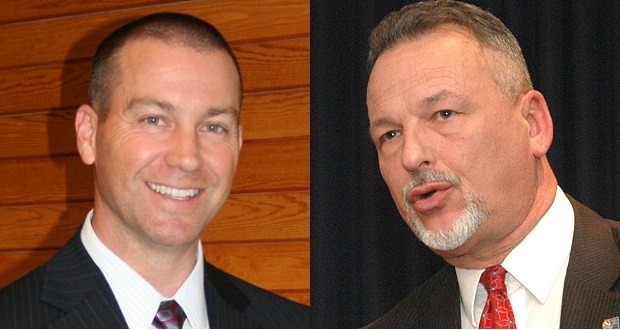Shared DCS case files raise questions about possible privacy law violations
Gary Grado//April 17, 2015//[read_meter]
Shared DCS case files raise questions about possible privacy law violations
Gary Grado//April 17, 2015//[read_meter]

The Department of Child Safety and the Governor’s Office may have broken state and federal privacy laws that shield abused children when the agency shared files to expose flaws in the former director’s system for prioritizing cases.
At the heart of the matter is a binder containing nearly 130 pages of confidential DCS case files and a Nov. 15 memo written by DCS Director Greg McKay damning former Director Charles Flanagan’s system for prioritizing cases to cut into a backlog of 13,024 cases.
Flanagan was McKay’s boss when the binder was delivered to Gov. Doug Ducey’s top aides. Flanagan was summoned to the Governor’s Office on Jan. 6, the day after Ducey was sworn into office, to explain himself.
McKay declined comment for this story, and Ducey spokesman Daniel Scarpinato said he did not know who gave the binder to the Governor’s Office.
The Ducey administration contends that the Arizona Constitution gives the governor the authority to access confidential files, said Michael Liburdi, the governor’s general counsel.
That constitutional provision applies to any confidential record kept by the state, including child abuse cases, records of seriously mentally ill people under state supervision, medical records of anyone enrolled in AHCCCS, a person’s criminal history, or tax records.
Scarpinato said the governor had an obligation to look at the confidential abuse files because the safety of children was at issue. But evidence suggests the files fell into the hands of the governor in an effort to oust Flanagan.
The state law governing confidentiality of DCS records allows certain people access to them, but the governor is not listed among them. Someone found guilty of breaking DCS confidentiality laws can be sentenced to up to four months in jail and fined up to $750. The state could also lose federal funding that goes to DCS to prevent child abuse.
The state privacy law is written to comply with federal laws governing privacy for abused children.
Flanagan said he had provided redacted copies of case files to Gov. Jan Brewer’s staff on occasion, but anyone who saw them was required by DCS policy to sign a document acknowledging they were looking at confidential files and were required to keep the information secret. Flanagan said that didn’t happen in this case.
Ducey fired Flanagan on Feb. 10 and appointed McKay, who, along with Maricopa County Attorney Bill Montgomery, had been challenging Flanagan’s system since Ducey’s election.
Liburdi said no laws were broken, as the governor and his staff have the constitutional authority to examine any confidential files kept by a state government agency. He said that constitutional provision trumps all state privacy laws.
Liburdi relies on a sentence of the provision that says the governor “may require information in writing from the officers in the executive department upon any subject relating to the duties of their respective offices.”
Attorney Tom Ryan said Liburdi’s interpretation of the Constitution would give the governor dangerous, limitless power. Ryan gained experience in Arizona child-abuse confidentiality laws while specializing in cases involving the misdiagnosis of Munchausen syndrome by proxy.
“This whole idea that the governor can be as bad as he wants to be under that constitutional provision is nonsensical,” Ryan said.
He said the purpose behind confidentiality laws is not only to protect children and families, but protect people who report child abuse.
Scarpinato said the Governor’s Office will consider matters involving confidentiality laws on a case-by-case basis.
“When a concern about the safety of children in the state’s care is brought forward, the governor has both an obligation and the constitutional authority to review it,” Scarpinato said.
Dan Barr, an attorney who specializes in First Amendment issues, said the provision could be read to mean the governor has the power to require people under the executive branch to provide him with written reports.
“This section is obviously very broad in the Constitution. Whether it allows them to override statute is what the courts would decide, but there’s no clear answer to that,” Barr said.
THE BINDER AND THE LAW
Children and families who are the subjects of DCS investigations are given confidentiality by law.
Arizona’s statute governing that confidentiality is written in accordance with the federal Child Abuse Prevention and Treatment Act, or CAPTA, as a condition for receiving federal funds devoted to preventing child abuse.
Kenneth Wolfe, a spokesman for the U.S. Department of Health and Human Services Administration for Children and Families, said states must assure the protection of all child abuse and neglect reports to protect the rights of the children, their parents and guardians.
Wolfe said states may release information to people who are the subjects of reports, a grand jury or court, or “other entities or classes of individuals statutorily authorized by the state to receive such information pursuant to a legitimate state purpose.”
States must provide information to child abuse citizen review panels, child fatality review panels, or any government agency that needs the information to carry out its responsibilities under law to protect children from abuse and neglect, Wolfe said.
And states are also required to disclose information related to the death or near death stemming from child abuse or neglect. Arizona’s practice has been to publish summaries of deaths and near deaths on the DCS website and summaries of any previous reports involving the victim.
Some of the people or groups allowed access to the information are county medical examiners, federal and state auditors, standing legislative committees, and lawmakers.
Anyone not specified by statute to see the information must ask a court to get authorization.
Scarpinato said he is unsure of when the binder filled with confidential files was delivered to the Governor’s Office.
Flanagan said the confidential information included portions of case files associated with six cases McKay summarized in his Nov. 15 memo alleging deficiencies in Flanagan’s triage system.
The Arizona Capitol Times received the binder through a public records request with 127 pages totally redacted, pursuant to the state’s law governing DCS confidentiality.
DCS would not confirm that the redacted pages were associated with the summaries in the memo, citing the confidentiality law. But the agency did confirm that a case that was prominently mentioned in the memo involved a malnourished 3-year-old boy from Cochise County.
That case was posted Feb. 23 on the DCS website as a near fatality, but there is a question of whether the case was considered confidential when it was given to the governor on Jan. 5.
A physician must certify that a child was in serious or critical condition as a result of the abuse for a case to be considered a near fatality and legally suitable for disclosure to the public.
McKay and the DCS staff in charge of posting cases online disagreed in late January whether the case qualified as a near death.
Robert Bell, who was DCS chief of investigations at the time, said medical records didn’t indicate the boy was seriously injured, according to a DCS email obtained by the Capitol Times.
McKay wrote in a Jan. 26 email to staff members who reviewed child fatalities and near fatalities: “We have since verified with Dr. Cramton who said the following, ‘I would say he was in critical condition both from a refeeding perspective and an impact on the rest of his life perspective.’”
Dr. Rachel Cramton, a pediatrician at the University of Arizona Medical Center, declined to comment for this story.
As for the five other cases summarized in the memo, it doesn’t appear any of them were posted on the DCS website between the dates of their respective incidents and Jan. 5, the day Ducey received the binder, meaning they weren’t public at the time. And none of those cases appear to be public to date.
THE FEUD AND THE STARVED CHILD
McKay is a former Phoenix police homicide detective who specialized in investigating and preventing child deaths. He was tapped to build the Office of Child Welfare Investigations from the ground up in 2012, an agency that was the cornerstone reform of Brewer’s Child Safety Task Force.
Flanagan has been in state government for 29 years, starting as a Department of Corrections officer and working his way to deputy director of the department and director of Department of Juvenile Corrections.
His path crossed McKay’s after McKay discovered nearly 7,000 child abuse and neglect cases in November 2013 that were closed without investigation and given the unofficial disposition of NI, or Not Investigated.
Brewer chose Flanagan to lead the task force charged with investigating those cases. Flanagan was also Brewer’s choice to build and run DCS, formerly Child Protective Services. The Legislature moved it from under the Department of Economic Security and turned it into a standalone agency reporting directly to the governor.
The agency began operating in its current form in May 2014, but a backlog of 13,024 cases had developed because the agency had spent months tackling the uninvestigated cases.
Records show Cramton tipped off the Office of Child Welfare Investigations about the Cochise County boy just after DCS removed him from his home on Sept. 3.
McKay began questioning Flanagan about the case on Nov. 5, the day after Ducey was elected governor.
McKay was dismayed that two reports involving the boy were part of the backlog. In his Nov. 15 memo to Flanagan, he provided a listing of more than a page of concerns about the case and questioned the effectiveness of Flanagan’s plan to address the backlog of cases.
The boy’s medical records, which are now public record, say his skull was visible through his thin scalp, brown saliva dangled from his lip when he was brought in and he tried to eat a Crayon when someone gave it to him for a distraction. A photo of the boy on his back shows his condition was comparable to third-world starvation cases.
The boy had to learn to eat again and doctors had to monitor his eating so as not to shock his starved system.
Flanagan said he stands by the triage system he put in place, despite the boy’s condition.
“It was a horrific event, it was one of those things we wish we could have prevented, but I’m not sure that any process that we put in place other than having enough people to go out and see all 13,024 cases and the probably 26,000, 27,000 children associated with those cases all at once could have resolved,” Flanagan said.
McKay complained that the Office of Child Welfare Investigations wasn’t part of the process for developing a triage system. He said in an email to Bell that it appears “cases go to never-never land on caseworker directories,” the system was “dangerous and unsafe” and appeared “hauntingly” similar to the system in which the NI designation was used.
Flanagan swung back.
“I am outraged by your unfounded, inflammatory and inaccurate statements of opinion,” Flanagan wrote. The former director ordered McKay to defend his assertions in writing and skip the “hyperbole or unsupported opinion.”
The result was the Nov. 15 memo criticizing Flanagan’s system.
County Attorney Bill Montgomery also jumped into the fray, demanding answers from Flanagan in emails and telling him he didn’t think the backlog was being tracked closely enough. Montgomery copied Ducey Chief of Staff Kirk Adams and Liburdi on his emails.
Flanagan said he was called to Adams’ office on Jan. 6 with only 30 minutes’ notice. During the meeting, he said Adams slid the binder across the table and demanded an explanation.
Flanagan defended the process in person and produced a 189-page binder of his own the next day, but without any confidential material.
He said he didn’t speak with Adams again until he was fired, which was at the same time Ducey was introducing McKay as the new director.

















